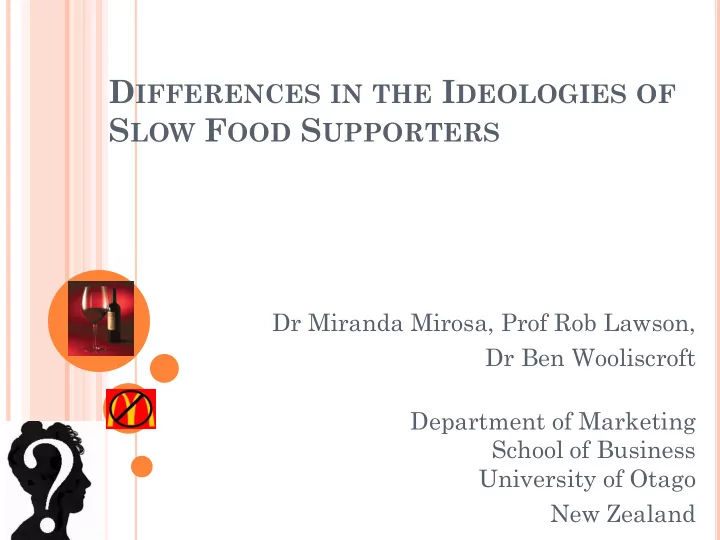

D IFFERENCES IN THE I DEOLOGIES OF S LOW F OOD S UPPORTERS Dr Miranda Mirosa, Prof Rob Lawson, Dr Ben Wooliscroft Department of Marketing School of Business University of Otago New Zealand
O UR L INE OF A RGUMENT Must understand oppositional ideologies to understand CR and AC! But in marketing, we know little about this concept One reason is a lack of theory in the area of consumer movements (CMs) Makes sense to classify CMs as a collective form of consumer resistance and to start developing theory about ideology in this context
R ESEARCH Q UESTION How does ideology vary amongst different types of CM supporters?
Definitions of Ideology Descriptive definitions of ideology are purely explanatory and they discuss this concept in a neutral sense (worldview) Pejorative definitions of ideology refer critically or negatively to the relations of power and maintaining dominance. If the motivation is unconscious then this is considered as self-deception. Here ideology means ideas which are fundamentally flawed Positive definitions of ideology consider the concept in a more favourable light. Eagleton (1991, p. 44) describes that here ideologies mean “a set of beliefs which coheres and inspires a specific group or class in the pursuit of political interests judged to be desirable”. It is this positive sense that ideology is defined in this thesis
U NDERSTANDING T YPES OF M OVEMENT S UPPORTERS C OVA , B., & C OVA , V., 2002,
M ELUCCI ’ S T HEORY Form of ideology A definition of self-identity, opposition and totality Content and the role of ideology Formative phase - 2 elements characterise ideology: theme of rebirth negation of the gap between expectations and reality Growth phase - 2 aspects of ideology become important: it fulfils a function of integration with respect to the movement as a whole it fulfils a strategic function in relation to the environment
O UR FRAMEWORK Combines: Cova and Cova’s typology of tribal membership roles + Melucci’s theory of social movement ideology Our study uses this framework to explain how ideology varies amongst the different categories of CM supporters
Slow Food Organisation Slow Food Movement
M ETHODOLOGY Collected published material by and about the SF Movement 18 face-to-face semi-structured interviews (official members of the SF Organisation or supporters of the wider SF Movement) Research propositions (derived from Melucci’s framework of ideology) were used to guide data collection and analysis Respondent classification into typology determined by level of movement involvement (behavioural & habitual elements)
F INDINGS Found important distinctions in the content and the role of ideology for the different supporters categories An example: Differences in the definitions of what SF means Sympathisers/Participants define SF as: about slowing down, taking the time to cook quality foods (‘good’ food) Practitioners/Members’ analytical vision of SF is much broader: Practitioners - emphasis is on the relationship between food and the environment (‘clean’ food ) Members - SF is about an array of gastronomic, environmental and social justice issues (‘good, clean and fair’ food)
D ISCUSSION Supporters are at different stages of ideological development Sympathizers & Participants = ‘Formative’ phase, Practitioners & Members = ‘Consolidation’ phase Our proposed framework appears useful to help understand the differences in ideologies These findings provide initial insights into the diffusion of ideologies amongst movement supporters (and movement structure)
C ONCLUSION Cova and Cova’s (2002) lens allows a wider and more holistic view of a movement’s support base + Melucci’s (1996) lens allows an understanding of how movement ideologies are constructed and used = A practical way of dealing with the diversity of ideologies that exist within a movement! ------------------------------------------------------------------------------ Theoritcal Contribution: Makes a step towards understanding oppositional ideologies in the context of CR and AC!
Thank You Dr Miranda Mirosa Marketing Department School of Business University of Otago New Zealand miranda.mirosa@otago.ac.nz
Recommend
More recommend